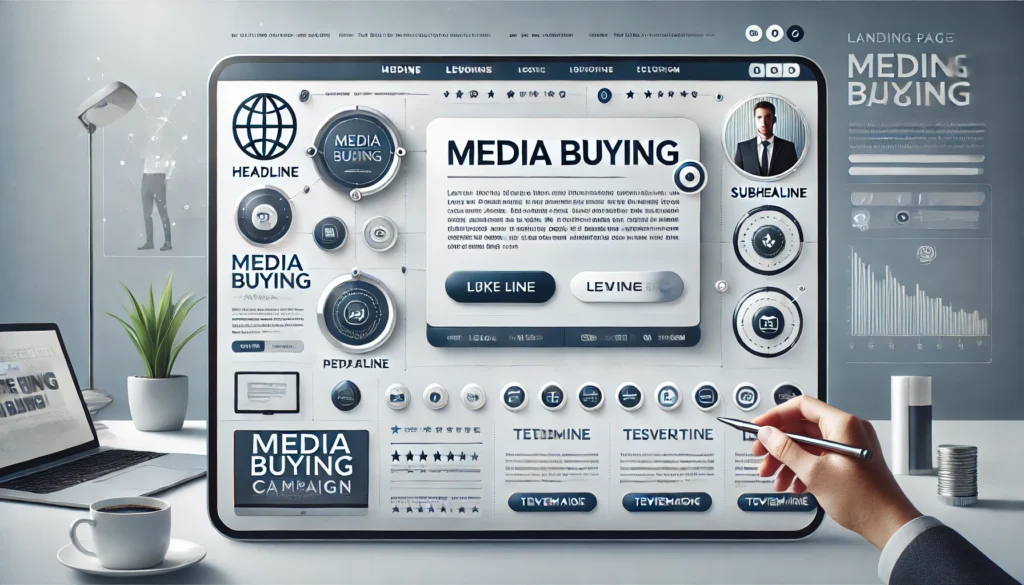Creating an effective landing page is essential for the success of any media buying campaign. Landing pages are where visitors land after clicking on your ad, and they play a crucial role in converting traffic into leads or sales. This comprehensive guide will walk you through the steps to build effective landing pages for your media buying campaigns, ensuring you maximize your return on investment (ROI).

Understanding the Importance of Landing Pages
Landing pages are different from regular web pages because they are specifically designed to capture a visitor’s information through a form or to encourage them to take a specific action, such as making a purchase. The effectiveness of your landing page can significantly impact your campaign’s success, as it directly influences the conversion rate.
Key Elements of a High-Converting Landing Page
1. Compelling Headline: Your headline is the first thing visitors see. It should be clear, concise, and attention-grabbing.
2. Engaging Content: The content should be relevant to the ad that brought the visitor to the page. It must be clear, engaging, and concise.
3. Call to Action (CTA): A strong CTA encourages visitors to take the desired action. It should be clear, prominent, and compelling.
4. Visual Elements: Use high-quality images and videos to make your page visually appealing and to convey your message more effectively.
5. Form: If you are capturing leads, ensure your form is simple and only asks for essential information.
6. Trust Signals: Include testimonials, reviews, and trust badges to build credibility and trust with your visitors.
Step-by-Step Guide to Building Effective Landing Pages
Step 1: Define Your Goal
Before you start designing your landing page, define its goal. What action do you want visitors to take? Common goals include:
– Capturing leads through a signup form
– Driving sales of a product or service
– Encouraging visitors to download an e-book or whitepaper
– Getting visitors to register for a webinar
Having a clear goal will guide the design and content of your landing page.
Step 2: Understand Your Audience
Understanding your target audience is crucial. Know their needs, preferences, and pain points. This knowledge will help you create a landing page that resonates with them and addresses their concerns.
Step 3: Craft a Compelling Headline
Your headline should clearly convey the value of your offer. It must grab the visitor’s attention and make them want to learn more. Keep it short, clear, and benefit-focused.
Example: “Unlock Your Full Potential with Our Advanced Marketing Course”
Step 4: Write Engaging Content
Your content should be concise and to the point. Use bullet points, short paragraphs, and subheadings to make it easy to read. Highlight the benefits of your offer and how it can solve the visitor’s problem.
Example:
– Learn cutting-edge marketing strategies
– Increase your ROI with proven techniques
– Get certified and advance your career
Step 5: Design an Eye-Catching Layout
The layout of your landing page should be clean and visually appealing. Use plenty of white space to avoid clutter. Place your most important elements, such as the headline, CTA, and form, above the fold to ensure they are seen without scrolling.
Step 6: Create a Strong Call to Action (CTA)
Your CTA should stand out and clearly state what you want the visitor to do. Use action-oriented language and make the button prominent.
Example: “Get Started Now”, “Download Your Free Guide”, “Sign Up Today”
Step 7: Use High-Quality Visuals
Visual elements such as images and videos can make your landing page more engaging. Use high-quality visuals that are relevant to your offer. A short video explaining your product or service can be very effective.
Step 8: Optimize Your Form
If your goal is to capture leads, make sure your form is optimized. Ask only for the essential information to reduce friction. The fewer fields, the better.
Example: Instead of asking for a full address, just ask for the email and name.
Step 9: Add Trust Signals
Trust signals such as testimonials, reviews, and trust badges can increase the credibility of your landing page. Include quotes from satisfied customers, case studies, or logos of well-known clients.
Step 10: Test and Optimize
Once your landing page is live, continuously test and optimize it. Use A/B testing to compare different versions of your page and see which one performs better. Test elements such as headlines, CTAs, images, and forms.

Best Practices for Building Effective Landing Pages
Keep It Simple
A simple, uncluttered design helps visitors focus on the main message and CTA. Avoid unnecessary elements that can distract or confuse visitors.
Match the Ad and Landing Page
Ensure that your landing page matches the ad that brought the visitor there. The headline, images, and overall message should be consistent to provide a seamless experience.
Mobile Optimization
Many visitors will access your landing page from mobile devices. Make sure your page is mobile-friendly and loads quickly. Use a responsive design that adjusts to different screen sizes.
Load Speed
Page load speed is critical for user experience and SEO. Optimize your landing page to load quickly by compressing images, using efficient code, and leveraging browser caching.
Clear Navigation
Remove or minimize navigation links that can take visitors away from your landing page. The goal is to keep them focused on the action you want them to take.
Analyzing and Improving Landing Page Performance
Use Analytics Tools
Use tools like Google Analytics to track the performance of your landing page. Monitor metrics such as bounce rate, time on page, and conversion rate to understand how visitors interact with your page.
Conduct A/B Testing
A/B testing allows you to compare different versions of your landing page to see which one performs better. Test one element at a time to isolate the impact of each change.
Example: Create two versions of your CTA button – one that says “Download Now” and another that says “Get Your Free Guide”. Compare the conversion rates to see which CTA is more effective.
Gather Feedback
Collect feedback from users to understand their experience with your landing page. Use surveys, user testing, and heatmaps to gain insights into how visitors interact with your page and where they encounter issues.
Make Data-Driven Decisions
Use the data you collect to make informed decisions about how to improve your landing page. Continuously optimize your page based on performance data and user feedback.
Conclusion
Building effective landing pages is crucial for the success of your media buying campaigns. By following the steps outlined in this guide, you can create landing pages that engage visitors, build trust, and drive conversions. Remember to continuously test and optimize your landing pages to achieve the best results. With the right approach, your landing pages can become powerful tools in your affiliate marketing strategy, helping you to maximize your ROI and achieve your business goals.
